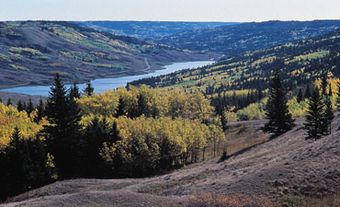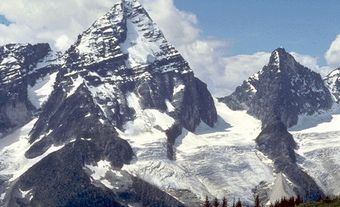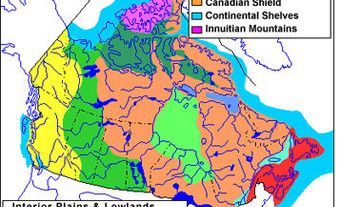
Ocean Current
An ocean current is a large (100 km or more), mostly permanent, horizontal movement of water at all depths in the oceans. Currents are generated by winds, excessive cooling or evaporation at the ocean surface (thermohaline processes) and tidal forces.
Wind-Driven Currents
In the Atlantic and Pacific oceans north of the equator, the combined effects of the strong westerly winds (between 30 and 60° N) and the northeastern trade winds (10-20° N) cause the near-surface waters to circulate in 2 large, clockwise gyres. Wind drag on the water is the primary driving force. The rotation of the Earth then causes the net movement of the upper layer (ie, Ekman layer, from 0-100 m depth) to be to the right of the wind direction (the Coriolis effect). A convergence of water develops in the Ekman layer between the westerlies and the trade winds, creating a high-pressure area in the ocean around which water circulates clockwise. In the Atlantic this subtropical gyre includes the Gulf Stream and the North Atlantic, Canary and North Equatorial currents; in the North Pacific, the North Equatorial, Kuroshio, North Pacific and California currents.
North of the westerlies, divergences in the Ekman layers create low-pressure areas leading to counterclockwise subpolar gyres. The North Atlantic subpolar gyre includes the North Atlantic, Irminger, Greenland and Labrador currents; the North Pacific subpolar gyre, the North Pacific, Alaska and Oyashio currents. The main currents in BAFFIN BAY are partly an extension of the North Atlantic subpolar gyre.
These ocean-scale gyres are asymmetrical: currents on the western side of the oceans, the Gulf Stream and the Kuroshio, are narrow (100 km) and strong (up to 2.5 m/sec). Zonal currents (those running west to east or east to west), and those on the eastern sides of the oceans are broad (500-1000 km) and slow (0.2 m/sec). The intensification on the western side results from an increase in the Coriolis effect between the equator and the North Pole, caused by the Earth's spherical shape. Speeds in the major currents diminish with increasing depth, rapidly in the upper 300 m, but there are significant manifestations of the strongest currents at the ocean bottom. The Gulf Stream and the Kuroshio are each estimated to transport, at their maximum, 15 x 107 m3/sec of water. This volume is roughly 15 000 times the average flow of the St Lawrence River or enough to fill Lake Superior in about one day.
South of the equator, the prevailing winds generate anticlockwise subtropical gyres that are similar but less intense than those in the northern oceans. The southern subpolar gyres merge to form a circumpolar current around Antarctica, as there are no landmasses to break up the flow into gyres. Ocean currents vary from day to day but, averaged over a month or so, they appear as constant features.
Variability can be caused by long-period waves (100 hr), especially when the current is in contact with the continental slope. Away from the coasts, the Gulf Stream and Kuroshio exhibit large meanders in their paths that have typical periods of 75 days. The meanders may be started by internal instabilities or by encounters with submarine mountains.
Thermohaline Currents
The second group of currents, those driven by thermohaline processes, are found below the wind-driven currents down to the bottom of the ocean. They are not important to high-seas commerce and are generally known only to oceanographers. Most of these deep flows are created by intense cooling of the ocean surface water in the Arctic and Antarctic. Cooling increases the density of water, causing it to sink. This new water (because it was recently at the sea surface) then moves away from the sinking region in distinct currents. High evaporation, eg, in the Mediterranean, also increases density and subsequent sinking by increasing the salinity of the water.
In the mid-ocean, alternate layers of water come from different locations. For example, in most of the North Atlantic Ocean, water at the bottom comes from the Antarctic, but north of 45° N and west of the mid-Atlantic Ridge, the bottom water comes from the Iceland Sea, through the Denmark Strait between Greenland and Iceland. Above this layer is the water known as the North Atlantic Deep Water that partly originates in the Norwegian Sea and flows into the Atlantic across the ridge between Iceland and the Faroe Islands. Next highest (at 1500-2000 m depth) are the intermediate waters. Labrador Sea water, renewed during severe winters in the deep water east of the pack ice off Labrador, is found in the North Atlantic (north of 45° N). This water is recognizable by its low salinity relative to the waters above and below. Mediterranean water flows out of the Strait of Gibraltar and is recognized over much of the North Atlantic by its high salinity, a result of excessive evaporation in the Mediterranean Sea.
Effects
Currents have 2 very important effects: they influence both FISHERIES and climate. Currents provide a means by which the deep, nutrient-rich waters are raised up to the sunlit surface layers, thus promoting biological productivity. They also transport significant quantities of heat which strongly influences climate in coastal areas. For Canadians, the most important currents are the LABRADOR CURRENT off the East Coast, and the North Pacific Current, off the West Coast. The Labrador Current gives rise to one of the world's largest fisheries on the Labrador Continental Shelf and the GRAND BANKS of Newfoundland. The North Pacific Current provides a vast reservoir of heat and water that is partly transferred to coastal BC to produce a mild climate and a large, productive forest industry.
See also COASTAL WATERS; TIDE.

 Share on Facebook
Share on Facebook Share on X
Share on X Share by Email
Share by Email Share on Google Classroom
Share on Google Classroom


